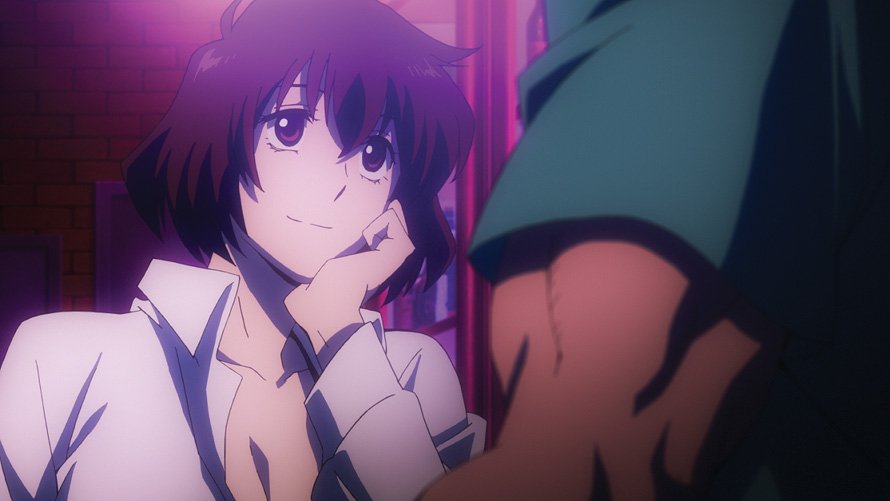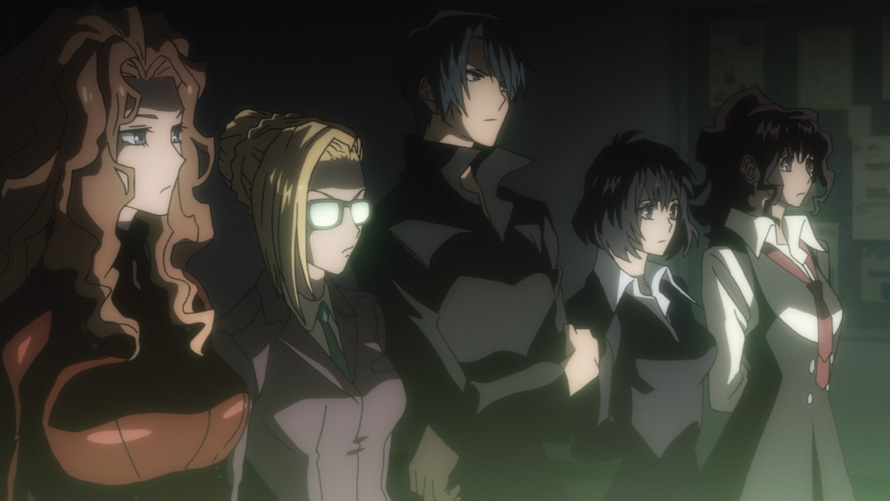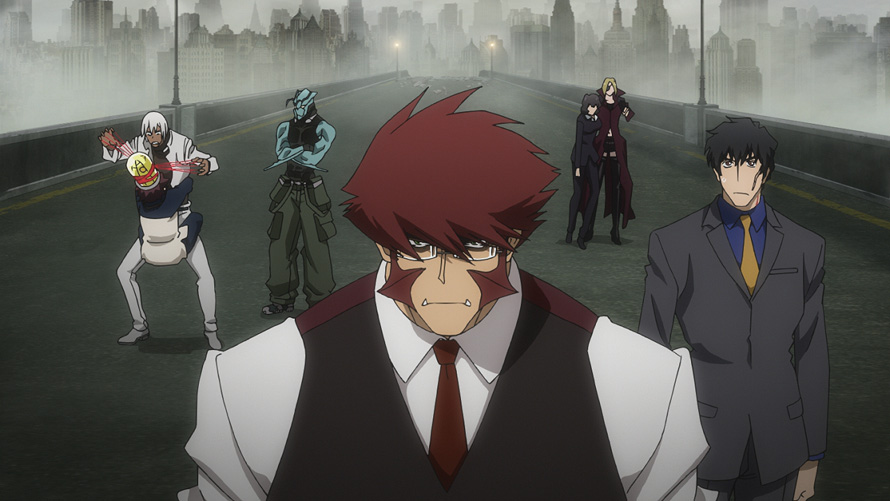
Blood Blockade Battlefront and Beyond continues the anime chaos unleased in Yasuhiro Nightow’s imagination.
One of my favorite anime series of 2015 was Blood Blockade Battlefront, and it isn’t solely because I’m a sucker for any show focusing on an elite unit of specialists stopping extraordinary threats. BBB’s stylishness elevated the affair beyond its conventional premise (by anime standards): when a gateway to an alternative world of fantastic beasts, magical powers, and other exciting supernatural phenomena opens in New York City, a mystical barrier of fog isolates it from the rest of the world to contain the breach. Years later, the abnormal has become normal. Now known as Hellsalem’s Lot, humans coexist with the creatures from beyond and the urban bustle goes on, even if catastrophic destruction of life and property is a daily occurrence. Devoted to keeping the situation contained is the secret organization “Libra” whose members possess superpowers that are generally powered by their own blood, though “contained” is open to interpretation…

The pandemonium continues with the hilariously clunky-on-purpose name of a second season, Blood Blockade Battlefront and Beyond. The first series focused primarily on rookie member Leonardo Watch, your typical wimpy yet morally upstanding guy except for the fact that he possesses the All-Seeing Eyes of the Gods which … well, you can mostly infer what they do based on the name. But while Leo remains prominent, in Beyond we finally get to spend some more time getting to know the rest of the cast thanks to each episode adapting stories from the original manga, created by Yasuhiro Nightow of Trigun fame. Two-parters aside, each of Nightow’s manga chapters are effectively stand-alone stories that are practically devoid of continuity, and while the first series opted to supplement the source material with a storyline that continued across episodes, Beyond knows what we’re here to see and that’s high-stakes wacky hijinks. My favorite is the one where fiery swordsman Zapp Renfro needs to find a prostitute witch’s missing cat before the hex she placed on his “freedom magnum” causes it to explode.
Cursed junk incidents aside, although Zapp (whose introductory onscreen text description is still displayed as “Dick Suck”) and Libra’s leader Klaus von Reinherz were the stars of the first season, this time around there is much more emphasis on Libra’s other members, such as Gilbert the bandaged combat butler and Klaus’s second-in-command, Steven Starphase. For my money’s worth, the standout this time around is Libra’s resident invisible “werewolf” girl, Chain Sumeragi, which is great because she got seriously shortchanged on screen time in the first series. That was probably because these world-building, character-focused stories that originally came much earlier in the manga all got skipped over in Season 1 for the sake of the serial narrative, but I prefer to think that we didn’t see much of Chain last season because, well, she was invisible.

With no strict continuity you technically could just jump straight into Season 2, but the chaotic world of Hellsalem’s Lot is dense enough that doing so deprives you of a fair bit of worldbuilding. Season 2 does add new cast members, including at least one whose only appearance in Season 1 ended up being during the infamous ending credits sequence, whose song by Unison Square Garden remains one of the most popular karaoke titles to this day. Naturally, they’re back to do the opening this time around! But the biggest change from BBB to BBB&B is that there’s now more time to slow down and get to know everyone better. I attribute this not only to the source material adaptation selection, but the new series director Shigehito Takayanagi (Dagashi Kashi), who having previously worked on Trigun is no stranger to Yasuhiro Nightow’s proclivities. (For the sake of my continued sanity, I’ll try not to dwell too much on the fact that the Trigun anime celebrates its 20-year anniversary in 2018.)
The director of the first season was noteworthy visionary young up-and-comer Rie Matsumoto (Kyousougiga), and while her breakneck pacing and unique cinematography were instrumental in giving Hellsalem’s Lot energy, you couldn’t really get much of a feel for these Libra folks aside from “Steven sure is awesome the way he froze those suckers to death by kicking them.” Matsumoto did at least make the ending credits sequence here, which is loaded with fun details, many of which are only visible for a few frames. Watch through it with a finger on the Pause button; as the series goes on, I promise the images will gradually make sense! What hasn’t changed between seasons is the animation quality. Doing justice to Hellsalem’s Lot as a setting requires extensive background artistry, an ability to create lots of distinct-looking creatures, and the raw ability to cram as many of them into dense crowd shots continually. Fortunately, just as before, the amount of animation talent that studio BONES (My Hero Academia, Cowboy Bebop) has assembled to give us top-notch cartoon insanity is mighty indeed, and is more than capable of keeping to the high standard that Rie Matsumoto set back in 2015.

With such a high frequency of disasters, the sheer amount of apathy to “collateral damage” has never been higher in anime. Hellsalem’s Lot is a world where buses have signs on them giving you the relative odds of your surviving the trip, yet the series is lighthearted and fun in tone since despite Libra having blood-powered abilities, gore and bloodshed is minimal. In this environment, people barely bat an eye at the notion of acquaintances dying from presumably being eaten by a swarm of recently sentient insects or having their breasts explode. THAT’S THE JOKE, gallows though it may be. Maybe since it happens off-camera and nobody brings it up later … they’re okay? Be it someone’s apartment exploding or a potentially world-ending catastrophe from an attempted elder god summoned by hackers, it seems that at most the attention of passers-by gets grabbed for a moment or two … and then it’s back to doing whatever it was they were doing before since, “Well, didn’t happen to me!” They could just keep making this show forever and I’d be happy, though by the time these 12 episodes conclude that more or less covers all that’s been written to date.
Blockade Battlefront and Beyond is available from Funimation and Crunchyroll.
This story appears in the April 2018 issue of Otaku USA Magazine. Click here to get a print copy.




![SSSS.Dynazenon [Anime Review] SSSS.Dynazenon [Anime Review]](https://otakuusamagazine.com/wp-content/uploads/2021/08/16-9-SSSS.Dynazenon_Key_Visual_3.5-480x360.jpg)
![Back Arrow [Anime Review] Back Arrow [Anime Review]](https://otakuusamagazine.com/wp-content/uploads/2021/07/ba15-02686-480x360.jpg)
![Dawn of the Witch [Manga Review] Dawn of the Witch [Manga Review]](https://otakuusamagazine.com/wp-content/uploads/2021/07/16-9-DawnoftheWitch-cvr_02-480x360.jpg)
![Nina The Starry Bride [Manga Review] Nina The Starry Bride [Manga Review]](https://otakuusamagazine.com/wp-content/uploads/2021/07/nina-the-starry-bride-v1-16-9-480x360.jpg)